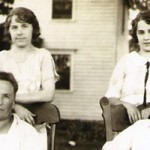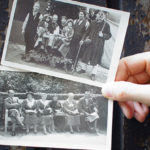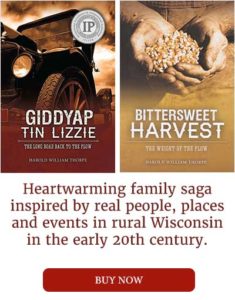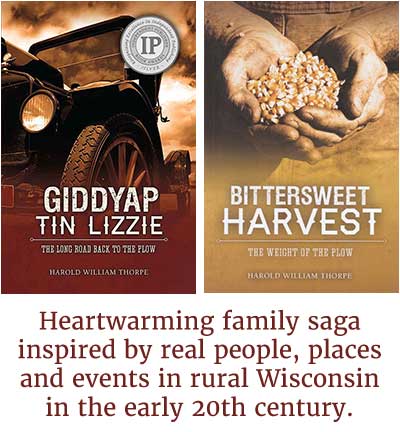When a family member tells you their story, they are speaking as a narrator – it is a narrative. If you write down what they tell you, you have written a simple narrative summary.
I assume that many of you will choose to write your story using a simple narrative summary style, like my mother did. But the simple narrative summary that Mother wrote can be enhanced by including many details.
Simple narrative summary
In her 1999 memoir, From High on the Bluff, my mother, Laura Annette Fitzsimons, wrote in simple narrative summary style. Here’s one example, about the day she and her sister, Alice, cheated their Great-Uncle Dick.
“Sometimes we went out in the country with our Great-Uncle Dick to plant pumpkin seeds and potatoes. He gave us twenty-five cents a day and a lunch that his daughter Emma cooked and put up. As I said before, Emma was one of the world’s best cooks; so it wasn’t too hard a job for us, given the rewards.
But one day we got tired, and Alice said, ‘Let’s put the rest of the seeds under this stump and say we didn’t have any left.’ So we did—and it worked. Alice always came up with these bright ideas, and I thought she was some kind of god; so I did everything she told me to do.”

When I set out to transform mother’s memoir into historical fiction, I needed more. I needed details to flesh out the story, to make it come alive.
My mother’s bare-bones narration doesn’t explain why she and Alice wanted to earn some money. It doesn’t describe the difficulties they had in planting the seeds, and how that spurred them to take a deceptive shortcut. And it doesn’t elaborate on Alice’s cunning or the two sisters’ different personalities.
Detailed narrative summary
Adding details like these creates more interesting characters and interactions. It expands the readers’ knowledge, helps them relate to the characters, and draws them into the characters’ world.
From High on the Bluff could have been written in an expanded, more informative, more interesting narrative summary style. Mother could have written the following:
“Sometimes we went out in the country with our Great-Uncle Dick to plant pumpkin seeds and potatoes. He gave us twenty-five cents a day and a lunch that his daughter Emma cooked and put up. Emma was one of the world’s best cooks; so it wasn’t too hard a job for us, given the rewards.
One spring, Alice and I were in desperate need of income because we wanted to help our sister, Annie, buy a dress for her school’s spring ball. Annie was fifteen, I was eleven, and Alice was thirteen. Being older, Annie was like a second mother to Alice and me. She helped Mother with housework, mended our clothes, and cooked our meals. She often interceded on Alice and my behalf when we got into trouble or had special wants. We had our spats, but I adored this older, kindly, sister.
Alice and I knew how much Annie wanted this dress, but we were deep into the Depression years and Dad didn’t have money to buy anything more than necessities. But he had promised, counting on a car repair payment he expected from Earnest O’Doul, to make the dress purchase. And Annie was expecting it, too. She told us, ‘Dad keeps his promises.’ But when Earnest O’Doul needed the money for his sick daughter, Dad agreed to wait another month. That would be too late for Annie. Her ball was Saturday night.
I prayed about it, asking God to find a way for us to help get that money. And I believed my prayers were answered when Great-Uncle Dick asked us to help plant pumpkins seeds in his big field.
We were eager, but the day was uncommonly hot for May. By noon the sun scorched our skin and hardened the ground, making digging difficult. After a brief lunch we continued to dig and plant seeds, but as we worked farther away from the wagon, we spent more time lugging our pails back and forth. Our clothes clung to our backs and soon we were so exhausted that we collapsed in the shade under the wagon. After awhile Alice rose to her elbow and said, ‘I’ve got an idea. Did you see that big hollow stump across the field?’ She led me across the field, pointed to the old weathered stump, and said, ‘Let’s put the rest of the seeds under this stump and say we didn’t have any left.’
Alice’s ideas always got me into trouble, so I was hesitant at first. When I resisted, Alice tried to convince me by saying that the day was hotter than we’d expected, and Dad says people get more money when working conditions are difficult. It sounded reasonable, but, deep down, I knew better. Yet I followed like a lamb to the slaughter.
Alice always came up with these bright ideas, and I thought she was some kind of god; so I did everything she told me to do.”
Give it all the details that you’ve got and more
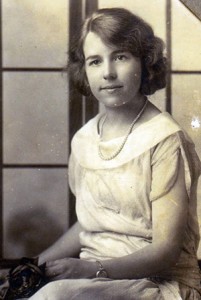
This more detailed narrative summary includes all that my mother wrote—and more. It gives the rationale for my mother and Aunt Alice wanting the money. It identifies the difficulty the girls faced as they tried to do their good deed, and shows how devious and convincing Alice could be—and how she manipulates a well-intending but compliant younger sister.
When you add details like these you create more interesting characters and interactions. You’ll expand the readers’ knowledge, help them relate to the characters, and draw them into the characters’ world.
Adding detail will enhance any of your writing, whether it’s fiction or non-fiction.
And then be ready to edit!
Resources
Want to learn more about writing Narrative Summary? Try these links:
Examples of Narrative Summary: The Writing Manual
Six Impossible Things: Patricia Wrede
Writing Tools: Narrative Summary
Next up
In the next installment of the Write Your Family Story series I’ll talk about the importance, in a fictional novel, of the ebb and flow of tension that keeps readers turning your pages to the very end.
Next: Write Your Family Story: Part 5 – Tension
Start at the top: Write Your Family Story Series Introduction


